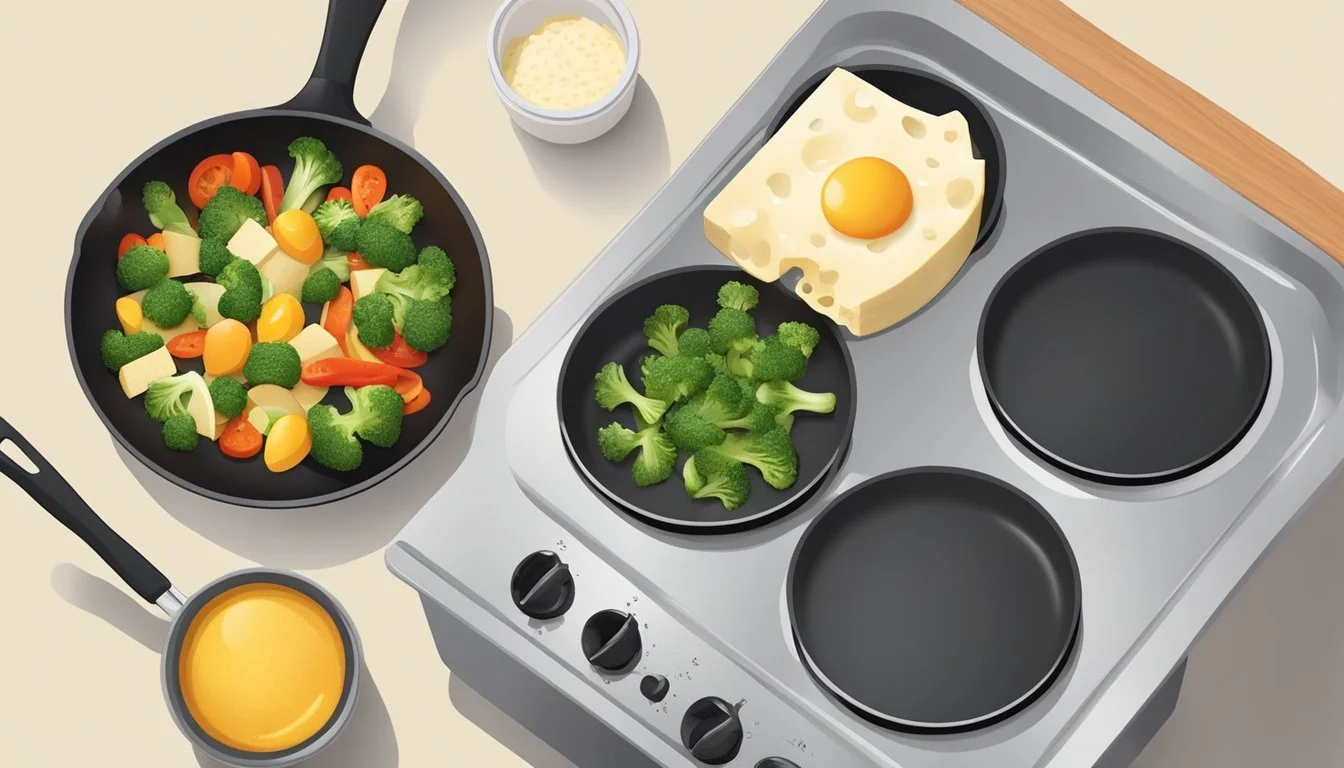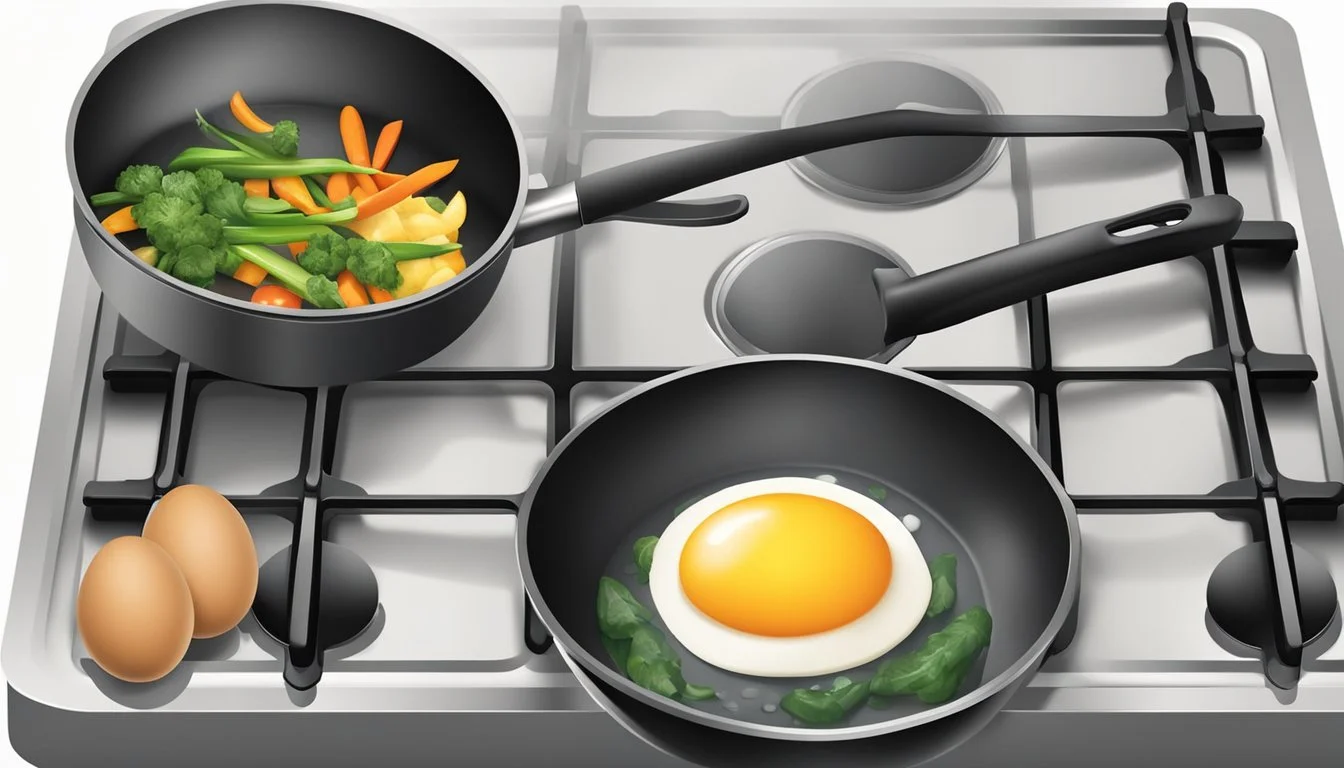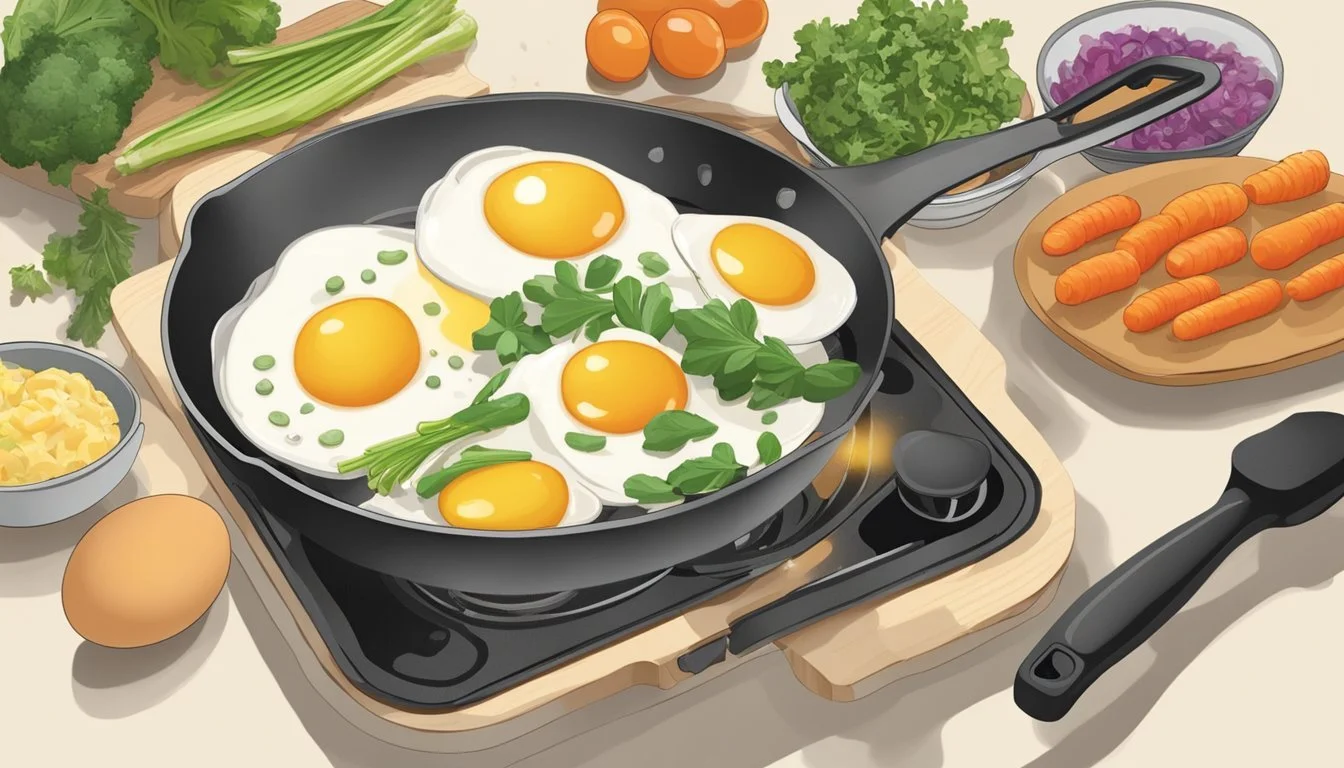How to Make a Frittata Without an Oven-Safe Skillet
Alternative Cooking Methods Explained
A frittata is a versatile Italian egg dish that can be enjoyed for any meal of the day. Comparable to an omelet or a crustless quiche, the frittata serves as a canvas for a variety of ingredients, from fresh vegetables to cheeses and meats. While traditionally frittatas are started on the stovetop and finished in the oven, not every kitchen is equipped with an oven-safe skillet.
Fortunately, one can still achieve a perfectly cooked frittata using a regular skillet on a stovetop. This method involves carefully cooking the eggs and fillings, then gently flipping the frittata to ensure even cooking without the need for an oven. The key is to maintain a gentle heat to avoid burning the bottom, and to use a plate or lid to help invert the frittata during the cooking process.
The stovetop method opens up the possibility to cook a frittata in kitchens that lack an oven or appropriate cookware. It also reduces cooking time and keeps the process simple. With practice, achieving a fluffy and evenly-cooked frittata on the stovetop becomes an easy task, allowing the dish to maintain its place as a quick and adaptable option for meals that impress.
Understanding Frittatas
In the culinary world, frittatas offer a versatile Italian dish that can be served for breakfast or brunch (What wine goes well with brunch?). Rich with eggs and various fillings, they are a robust custard-like meal prepared primarily on the stovetop.
Frittata Basics
A frittata starts with beaten eggs that set into a dense and rich base, similar to custard, as they cook. Unlike other egg dishes, it traditionally involves sautéing chosen fillings in a skillet before pouring the eggs over them and allowing the mixture to cook slowly. The result is a dish that's firm enough to be cut into slices. For those without an oven-safe skillet, cooking a frittata requires a bit of ingenuity in finishing the top side of the dish since it cannot be placed directly into the oven to broil.
The essential elements of a typical frittata recipe include:
Eggs: The primary ingredient acting as the binding agent.
Fillings: Can include vegetables, cheese, meat, or herbs, precooked and distributed evenly before the egg is added.
Dairy: Often a bit of cheese or cream to enrich the mixture, although not mandatory.
Cookware: A stovetop pan, preferably nonstick, will be used with a secondary method to finish cooking the top.
Frittata vs. Omelet vs. Quiche
Frittatas differ from omelets and quiches mainly in preparation and texture.
Omelets are egg dishes typically made by cooking beaten eggs in a pan, then folding them over a filling. They are usually cooked entirely on the stovetop, and have a lighter, fluffier texture.
Quiches, on the other hand, are primarily baked French dishes consisting of a pastry crust filled with eggs, cream, cheese, and other fillings. Quiches have a richer, custard-like consistency and often served from the pie-like crust.
Distinguishing Factor Frittata Omelet Quiche Cooking Method Stovetop (finish on top optional) Stovetop Baked Consistency Dense, custard-like Fluffy, folded Custard-filled pastry crust Serve Style Sliced Folded Pie slice
The key difference lies in the cooking technique and final presentation, with frittatas being an excellent option for those seeking a hearty meal, suitable for any time of day, without the need for specialized bake-ware.
Essential Ingredients
Crafting the perfect stovetop frittata hinges on the selection of fresh, flavorful ingredients. From the foundation of high-quality eggs to the variety of cheeses and fresh vegetables, each component contributes to the frittata's rich taste and texture.
Choosing the Right Eggs
Eggs are the bedrock of any frittata. Opt for fresh, organic or free-range eggs when possible, as they tend to have richer flavors. A general rule is to use 6 to 8 large eggs for a frittata that serves 4 to 6 people.
Selecting Vegetables
Incorporating a colorful medley of vegetables not only boosts nutritional value but also adds visual appeal. Popular choices include:
Spinach or baby spinach: Wilted in olive oil for a tender texture.
Onions and red bell peppers: Sautéed until soft.
Zucchini: Thinly sliced or chopped.
Tomatoes: Cherry tomatoes sliced in half, or diced regular tomatoes to avoid excess moisture.
Kale and asparagus: Chopped and lightly cooked to maintain their vibrancy and bite.
Cheese Varieties in Frittatas
Cheese adds depth and creaminess to your frittata. Consider these options:
Cheddar: Sharp and melts well.
Mozzarella: Delivers a subtle taste and creamy texture.
Swiss or Swiss cheese: Nutty flavor; pairs well with mushrooms.
Feta: Tangy kick, crumbles easily.
Parmesan: Aged and salty, ideal for a sharper finish.
Goat cheese: Adds a distinct tartness.
Adding Meats and Other Proteins
For those who desire a heartier frittata, include meats and alternative proteins like:
Bacon or ham: Cooked and diced.
Italian sausage: Browned and crumbled.
Sprinkling of diced cooked potatoes for extra substance without overpowering other flavors.
Herbs such as dill or green onions: Mince finely to interlace with the eggs and not overpower the subtler ingredients.
Preparation Without an Oven-Safe Skillet
When one lacks an oven-safe skillet, the creation of a frittata is still possible through alternative stove-top techniques and the correct skillet choice.
Alternative Cooking Methods
A non-oven-safe skillet can still be used to prepare a frittata by employing a stove-top method. One starts by cooking veggies such as sliced tomatoes and seasoned vegetables until they are tender. They should be sautéed over medium heat in a seasoned non-oven-safe skillet, ensuring the vegetables are evenly cooked and seasoned with kosher salt and black pepper. Once the cooked vegetables are set, the whisked eggs – with the ideal egg-to-veggie ratio – are poured over the vegetables.
The challenge is in the final cooking phase where, typically, an oven would be used to evenly cook the top of the frittata. Instead, one can cover the skillet with a lid to allow the top to set from the steam or use a plate to carefully flip the frittata over to finish the uncooked side.
Using a Non-Stick Skillet
A non-stick skillet can function well for frittata preparation. Initially, eggs are beaten with a dash of salt and pepper. This mixture is then carefully poured into the skillet preheated to medium heat. As the bottom solidifies, one must ensure to loosen the edges with a spatula so that the frittata does not stick.
To circumvent the need for an oven, the cook may place a large plate over the skillet, flip the frittata onto the plate, and then slide it back into the skillet to cook the other side. This process is delicate and requires confidence. The result is a fully cooked frittata without an oven or oven-safe skillet. The nonstick property of the skillet is crucial to ensure that the frittata can be flipped without breaking and to make cleanup easier.
Cooking Techniques and Tips
When preparing a frittata without an oven-safe skillet, the texture of the eggs and the execution of the flipping technique are crucial for success. The cook should focus on heat control, ingredient ratios, and cooking methods to ensure a well-cooked and satisfying frittata.
Achieving the Right Texture
For a perfectly cooked frittata, the eggs need to be whisked properly. One should whisk just until the yolks and whites are blended to maintain a rich and tender texture. Avoid overbeating the eggs, as this can introduce too much air and result in an undesirably dry and spongy outcome. The ratio of eggs to dairy (like cream or milk) can be 6 to 8 large eggs to a 1/4 cup of dairy, with an addition of salt and pepper for flavor. The cooking process should begin on medium heat with a generous amount of olive oil to prevent sticking and allow even cooking.
Perfecting the Flip Technique
Flipping a frittata without an oven-safe skillet requires a tactical approach. Here's a step-by-step method to ensure a clean flip:
Once the bottom of the frittata has set, place a large plate over the skillet.
With a confident and swift motion, invert the skillet so the frittata transfers onto the plate.
Now, re-oil the skillet and gently slide the frittata back in to cook the other side.
Following these steps helps achieve a perfect frittata that is evenly cooked without the requirement of an oven.
Optional Enhancements and Variations
Creating a flavorful frittata without an oven-safe skillet is entirely feasible and can be quite exciting when incorporating a diverse array of fresh herbs, cheeses, and protein-packed ingredients. These enhancements leverage the inherent versatility of a frittata, offering an avenue for customization to individual taste preferences and dietary requirements.
Incorporating Fresh Herbs and Spices
Fresh herbs bring a bright, aromatic dimension to frittatas. Dill, for example, pairs beautifully with eggs. One can finely chop it and sprinkle it into the egg mixture before cooking. A combination of parmesan and green onions can add a savory depth, while a pinch of dried oregano offers a touch of warmth. The subtle use of spices allows the natural flavors of the other ingredients to shine through without overpowering them.
Creative Vegetable and Meat Combinations
A frittata's adaptability comes alive with thoughtful combinations of vegetables and meats. Spinach and mushroom, for instance, complement each other, with options ranging from baby spinach to more robust kale. Chopped tomatoes add juiciness, while arugula offers a peppery tang. For meat lovers, diced ham or crumbled sausage can turn a simple frittata into a hearty meal. When selecting cheese, melted parmesan or feta can elevate the dish, while using a milk or dairy alternative keeps it lighter. Balancing the quantities of these add-ins is key to ensuring every bite is packed with flavor and texture.
By choosing one's preferred mixture of vegetables, meats, and cheeses, they transform the basic egg canvas into an endless spectrum of delicious possibilities.
Serving and Presentation
A well-made frittata is as much about the flavors melded within as it is about the presentation and accompaniments. A good presentation enhances the dish's appeal, and thoughtful pairings can elevate the entire meal.
Plating and Garnishing
When serving the frittata, one should slice it neatly and transfer each portion carefully onto individual plates. Taking a cue from Italian cuisine, garnishing with fresh herbs, such as basil or oregano, adds both color and a hint of freshness. A dollop of sour cream, crème fraîche, or plain yogurt on the side can introduce a creamy texture and a tangy flavor to balance the dish's richness.
Suggested Garnishes:
Fresh basil or oregano sprigs
A spoonful of sour cream, crème fraîche, or yogurt
A sprinkle of salt and freshly ground pepper to taste
Pairing with Sides
For a satisfying meal, pair the frittata with a refreshing salad. A simple arugula salad, tossed with cherry tomatoes, olive oil, and a pinch of salt, complements the frittata's eggy base and harmonizes with the veggies and cheese within. The slight peppery bite of arugula contrasts the dish's richness and adds a fresh dimension to the palate.
Recommended Side Pairings:
Arugula and cherry tomato salad
Sautéed asparagus or steamed green beans
Slices of crusty bread or toasted baguette
Each component plays a vital role in creating a well-rounded experience that accentuates the flavors and textures of a stovetop frittata made without the use of an oven-safe cast iron skillet.
Storing and Reheating
When preserving a frittata, both refrigeration and freezing extend its shelf life, while reheating it requires specific techniques to maintain its quality. The following methods ensure that the frittata, whether made with roasted vegetables, (What wine goes well with roasted vegetables?) meats, or cheeses, retains its ideal texture and flavor during storage and subsequent reheating.
Refrigeration and Freezing
For refrigeration, leftovers should be allowed to cool to room temperature, then wrapped tightly in plastic wrap or stored in an airtight container. Properly refrigerated, a frittata will keep for up to 4 days. To freeze a frittata, one should first allow it to cool. Once cool, the frittata can be wrapped in aluminum foil or placed in freezer bags. Slices should be separated by parchment paper to prevent sticking. Frozen frittata lasts for about 1 month.
Best Methods for Reheating
Reheating a frittata should be done with care to preserve its texture.
Microwave: Place frittata slices on a microwave-safe plate and cover with a damp paper towel. Heat on high for 1 to 2 minutes or until warmed through.
Stove Top (without oven-safe or cast-iron skillet): Heat a non-stick skillet over medium heat. Add frittata slices, cover with a lid, and warm for a few minutes on each side.
Oven/Toaster Oven: Preheat to 350°F. Place frittata slices on a baking sheet lined with parchment paper. Heat for about 10 to 15 minutes. A frittata with components like roasted vegetables may require up to 20 minutes.
Air Fryer: Preheat to 300°F. Place the frittata in the basket and cook for 3 to 6 minutes, until heated through.
The broiler is not recommended for reheating as it can overcook the top before the inside is warm. If a frittata is frozen, it is best to thaw it in the fridge overnight before using any of the above reheating methods.
Healthy and Nutritional Considerations
When crafting a stovetop frittata, one can effortlessly incorporate a balance of proteins, healthy fats, and vegetables for a nutritious meal. This section focuses on understanding the caloric and nutrient composition of a frittata and how to adapt it for various dietary requirements.
Caloric and Macro-Nutrient Profiles
A frittata's caloric content primarily depends on the ingredients used. Traditional frittatas often include eggs as a rich source of protein and whole milk or cream for creaminess. To gauge the nutritional content, consider the following typical breakdown for one serving of a vegetable frittata made with whole milk:
Calories: 150-250
Protein: 10-15g
Carbohydrates: 2-4g
Fats: 10-18g
To reduce the number of calories and fats from dairy, use a low-fat dairy alternative or reduce the cheese and milk quantities. Incorporating a variety of vegetables adds essential vitamins and minerals with minimal caloric impact. Choose healthy fats like olive oil or avocado for cooking and garnishing to maintain the frittata's heart-healthy profile.
Dietary Adjustments for Special Needs
Adaptations for different dietary needs can be made while ensuring the frittata remains an easy breakfast option. Here are specific adjustments:
Low Lactose/Dairy-Free: Replace whole milk with almond, soy, or coconut milk. Use lactose-free or plant-based cheese.
High Protein: Boost protein by adding more eggs, including egg whites, or incorporating lean meats like turkey bacon or chicken.
Vegetarian: Ensure the frittata is vegetarian by focusing on eggs, dairy, and a variety of vegetables like kale, bell peppers, and onions.
Low-Calorie: Use low-fat dairy options and increase the ratio of veggies to eggs and cheese.
By adjusting the components, a frittata can be tailored to fit specific nutritional goals while remaining a healthy breakfast choice.
Frittata Recipes for All Occasions
Frittata recipes can be tailored for quick weeknight meals or dressed up for brunches and gatherings. They provide a canvas for a vast array of ingredients, catering to different tastes and dietary preferences without the need for specialized cookware.
Weeknight Dinner Frittatas
For a quick and satisfying weeknight dinner, a simple frittata recipe can come to the rescue. One can start with a base of 8 eggs, whisked with a touch of milk, salt, and pepper. A non-stick skillet works perfectly.
Ingredient Mix-ins: Saute preferred vegetables like spinach and peppers. Add pre-cooked proteins such as diced ham or crumbled sausage.
Cooking Steps: After the mix-ins are sauteed, pour the egg mixture into the skillet and cook over medium heat. Instead of transferring to an oven, one can cover the skillet with a lid or plate to allow the top to set, occasionally checking for doneness.
Tip: Leftover frittata makes for an excellent next-day lunch.
Brunch and Special Event Frittatas
Frittatas bring an element of elegance to brunch or any special event. Incorporate luxurious ingredients such as smoked salmon, goat cheese, or fresh herbs.
Ingredient Highlights: A combination of spring vegetables or a mix of wild mushrooms can elevate the dish.
Cooking Technique: To make the frittata fluffy and rich, one might add a dollop of sour cream to the eggs before cooking. For these occasions, finishing under a broiler (if available) gives a delightful golden top. If a broiler is not an option, utilize the cover-and-cook method, perhaps garnishing with fresh herbs or arugula for a pop of color.
Remember: Personalization is key in frittata recipes. Mix and match ingredients based on seasonal availability and personal preference to create a dish that resonates with the occasion.







